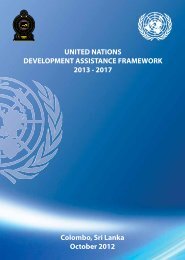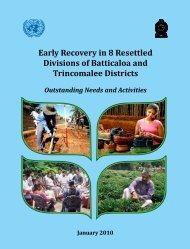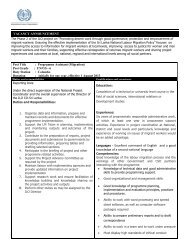Sri Lanka Human Development Report 2012.pdf
Sri Lanka Human Development Report 2012.pdf
Sri Lanka Human Development Report 2012.pdf
Create successful ePaper yourself
Turn your PDF publications into a flip-book with our unique Google optimized e-Paper software.
Agenda for Action<br />
Develop health policies to reduce the<br />
vulnerability of the very poor<br />
Of the three dimensions of the <strong>Human</strong> <strong>Development</strong><br />
Index, <strong>Sri</strong> <strong>Lanka</strong> scores highest on health. For some basic<br />
indicators, however, such as infant nutrition and maternal<br />
mortality, there are sizeable disparities in outcomes.<br />
According to multidimensional poverty analysis, poor<br />
health is the biggest contributor to poverty.<br />
At the national level, just over one in five children is<br />
underweight, and nearly one in six is stunted. In districts<br />
with large estate populations, such as Nuwara Eliya and<br />
Badulla, the picture worsens: almost one in three children<br />
is underweight and just above one in three is stunted.<br />
Women on the estates are underweight for their height,<br />
which predisposes them to illness. Stunting and wasting<br />
due to malnutrition are worst in some conflict-affected<br />
districts, such as Trincomalee and Batticaloa. Some rural<br />
districts, such as Moneragala and Hambantota, also have<br />
high levels.<br />
While the infant mortality rate has declined from 19.8<br />
per 1,000 live births in 1990 to 8.5 per 1,000 live births<br />
in 2007, there are considerable disparities across regions.<br />
It is particularly high on estates, as well as in Batticaloa,<br />
Colombo, Nuwara Eliya and Kandy, although the high<br />
rates in Colombo and Kandy could be due to errors in data<br />
collection. 329 Compared to the national average, maternal<br />
mortality is considerably higher in some conflict-affected<br />
districts, such as Killinochchi, Batticaloa and Ampara; in<br />
some districts with a high concentration of estate workers,<br />
such as Nuwara Eliya; and in some rural districts such as<br />
Moneragala.<br />
The Ministry of Health and other relevant national<br />
entities need to target more health resources to deprived<br />
and conflict-affected areas for a number of reasons.<br />
First, health outcomes are influenced not only by healthrelated<br />
services, but also by a variety of factors such as<br />
environment, income, working conditions, safety, etc.. An<br />
integrated approach is required.<br />
Second, especially in conflict-affected areas, medical<br />
facilities have been destroyed, the quality of remaining<br />
services is low, and there are few adequately qualified and<br />
experienced personnel. Both physical and human health<br />
infrastructure require attention, and could be integrated<br />
more seamlessly into the national health system.<br />
Third, more resources are needed to take on emerging<br />
health issues and upgrade health facilities throughout the<br />
country. A larger role for the private sector could bring<br />
in the much-needed resources. It already has a presence<br />
in the health sector, which helps to reduce congestion in<br />
public hospitals in urban centres and to provide specialized<br />
services. An expanded role would, however, require greater<br />
safeguards and closer monitoring.<br />
At the same time, the public sector will need to continue<br />
to operate in key areas to provide preventive programmes,<br />
and ensure equitable access to quality health care for all.<br />
The management of health care under the public system<br />
could be streamlined and made more efficient to increase<br />
returns. Timely collection and analysis to inform policy<br />
makers on operations and outcomes across the sector<br />
could improve monitoring and service delivery.<br />
Design and implement policies to address<br />
emerging and non-communicable diseases<br />
Lifestyle changes from rising incomes, cultural trends,<br />
technology and demography are altering the pattern of<br />
disease in <strong>Sri</strong> <strong>Lanka</strong>. Emerging health issues that require<br />
greater attention include communicable diseases such as<br />
dengue and leptospirosis; non-communicable diseases<br />
such as diabetes, hypertension and cardiovascular illnesses;<br />
mental health problems; and accidents and injuries. Noncommunicable<br />
diseases have a higher prevalence rate in<br />
more affluent districts, such as Colombo, Gampaha and<br />
Kalutara, and in urban centers such as Jaffna and Kandy.<br />
The concern about them is that they may be life-long,<br />
debilitating illnesses that reduce productivity and burden<br />
families, even as they require increasing amounts of public<br />
resources. Unless measures are taken to contain them and<br />
the other emerging health concerns, it will be difficult to<br />
sustain achievements in human development.<br />
Chapter 7<br />
Building on Peace, Progress and Security 121






